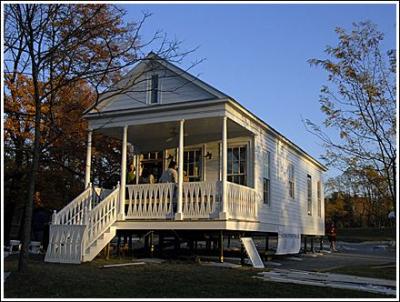
Katrina Cottages Move Beyond Gulf
Manufactured cottage brings affordable character to DC and the mid-Atlantic
Submitted on 11/18/2006. Tags for this image:Warning: Table './archive_cnu/watchdog' is marked as crashed and should be repaired query: INSERT INTO watchdog (uid, type, message, variables, severity, link, location, referer, hostname, timestamp) VALUES (0, 'php', '%message in %file on line %line.', 'a:4:{s:6:\"%error\";s:7:\"warning\";s:8:\"%message\";s:39:\"Invalid argument supplied for foreach()\";s:5:\"%file\";s:100:\"/var/www/archive.cnu.org/htdocs/sites/cnu.civicactions.net/themes/cnu/node-content_news_item.tpl.php\";s:5:\"%line\";i:13;}', 3, '', 'http://archive.cnu.org/cnu-news/2006/11/katrina-cottages-move-beyond-gulf', '', '3.129.20.112', 1730748848) in /var/www/archive.cnu.org/htdocs/includes/database.mysql.inc on line 135
 Download ( 0B)
Download ( 0B)SILVER SPRING, MD – Out of the storm zone, into the national consciousness and into the life of a Washington, DC-area family in need of a nice place to call home.
That’s the strategy behind the introduction on Saturday, Oct. 28, of the latest and most ambitious addition to the Katrina Cottage family of designs. A 523-square-foot “kernel” house that will eventually sport two add-on wings, this version will be the first Katrina Cottage to appear outside the storm zone, when it goes on display, beginning this Saturday at Gwendolyn E. Coffield Community Center in Silver Spring. In addition to being the first of "kernel" cottage built, the DC cottage features environmentally sustainable finishes such as bamboo flooring and can be adapted for full accessibility. Read about the future residents of the DC Cottage and "Katrina Cottage Industry" in the Washington Post.
Although an extended family of Katrina Cottages -- affordable, quickly built small houses of enduring character designed by CNU members – have earned an important role in the rebuilding of hurricane-damaged areas of the Gulf Coast, a Washington, DC-area Katrina Cottage became possible when USA WEEKEND magazine agreed to be media sponsor of an effort to create a Katrina Cottage especially for the region and feature it on its annual Make a Difference Day. With CNU signing on as a co-sponsor, the weekly magazine, with a readership of some 48 million, found another willing partner in Montgomery County, Maryland, which provides replacement housing for citizens in need of affordable alternatives in one of the nation’s most costly housing environments. After four to six weeks on display at the Coffield Community Center, the kernel cottage will move down the block to the lot owned by a single mom and her daughter. There, the kernel will be joined by the two wings to create a fully “grown” Katrina Cottage of more than 1,300 square feet. The DC cottage is the second fully manufactured Katrina Cottage by California-based Housing International, Inc., and the first built at its new Louisiana facility.
Bringing the cottages to new regions with a growing need for high-quality affordable housing is a logical next step, say CNU President John Norquist and CNU member Steve Mouzon, founder of the New Urban Guild and designer of the latest Katrina Cottage. “As soon as we started thinking seriously about the potential of the Katrina Cottage idea,” says Mouzon, “we saw that we could stimulate at least three conversations at the same time – one about safe, decent housing in the hurricane zone; one about affordable housing in the whole country; and one about the coming-of-age of manufactured housing as a source for high-quality, appealing housing that can be mass-produced at competitive prices. With this latest Katrina Cottage, I think we’re on our way.”
The Katrina Cottage idea was born in the CNU-led Mississippi Renewal Forum in Biloxi in 2005. Over the course of an eight-day charrette directed by CNU co-founder Andres Duany, some 200 designers, engineers, planners, and other specialists from Mississippi and around the world created plans for 11 storm-devastated Mississippi coastal communities and three counties. The cottages, originally conceived as FEMA trailer alternatives, quickly captured the imagination of not only storm victims but the nation’s builders and developers. The first cottage, Marianne Cusato’s award-winning “little yellow house,” was on display for 100,000 attendees at the 2006 International Builders Show in Orlando. That cottage was just selected as the winner of the People’s Design Award from the Cooper Hewitt National Design Museum in conjunction with its National Design Awards. Since the debut of that cottage, the designs and the interest have multiplied.
New Urbanists are heavily invested in the Katrina Cottage movement, because it not only addresses the immediate need for housing in the storm zone, it also invites a broader discussion of CNU’s most basic community-building principles. Quality small-scale housing represented by Katrina Cottages is a much-needed alternative in communities determined to address affordability issues without downgrading the architectural character of neighborhoods. Together, these cottages can work as clusters and bungalow courts that can enrich old and new neighborhoods and provide safe, affordable housing for people who might not qualify for quality architecture in larger scale. Yet conventional zoning often precludes this alternative because of setback, lot size, and other restrictions that force only larger homes on larger lots.
Talking seriously about Katrina Cottages means talking seriously about a whole collection of challenges and opportunities for community planning. CNU’s continuing advocacy for common-sense, comprehensive approaches to creating beautiful, functional places to live, work, and play will help this new wave of high design for small spaces realize its true potential.
Photo courtesy of Steve Mouzon

